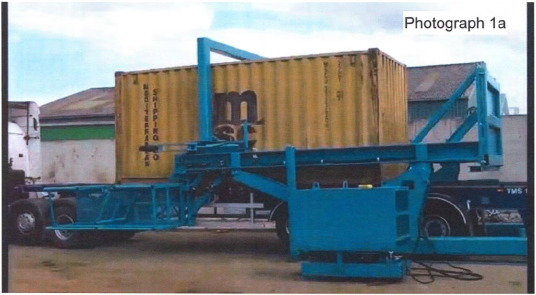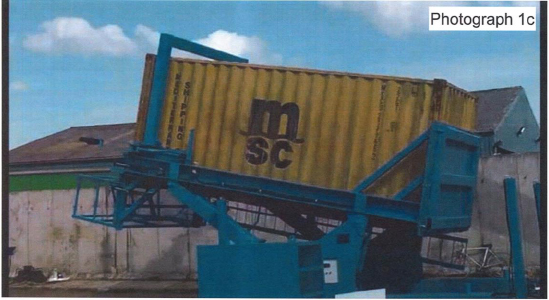A Ward Attachments Ltd v Fabcon Engineering Ltd
| Jurisdiction | England & Wales |
| Judge | Melissa Clarke |
| Judgment Date | 29 July 2021 |
| Neutral Citation | [2021] EWHC 2145 (IPEC) |
| Court | Intellectual Property Enterprise Court |
| Docket Number | Claim No: IP-2019-000102 |
[2021] EWHC 2145 (IPEC)
IN THE HIGH COURT OF JUSTICE
BUSINESS AND PROPERTY COURTS OF ENGLAND AND WALES
INTELLECTUAL PROPERTY LIST (Ch D)
INTELLECTUAL PROPERTY ENTERPRISE COURT (ChD)
Rolls Building
New Fetter Lane
London
HER HONOUR JUDGE Melissa Clarke
sitting as a Judge of the High Court
Claim No: IP-2019-000102
Mr Richard Davis (instructed by Browne Jacobson LLP) for the Claimant
Mr Jonathan D. C. Turner (instructed by Taylors Legal Services) for the Defendant
Hearing dates: 29 and 30 April 2021
Provided to the parties in draft on 24 July 2021
A. INTRODUCTION
This is judgment in a claim for infringement of two European patents which relate to an apparatus or device for receiving freight containers directly from the bed of a truck or trailer or other delivery mechanism, and tilting them to near-vertical to facilitate the loading and unloading of bulk materials.
The two-day trial was heard remotely over Teams in open court. The press and public were able to attend remotely if they wished to do so. Mr Richard Davis appeared for the Claimant and Mr Jonathan Turner for the Defendant and I thank them for their skeleton arguments and assistance.
The Claimant is a company registered under the laws of New Zealand (including the Cook Islands, Niue and Tokelau).
The Claimant is the registered proprietor of two patents in suit, both of which derive from the same international patent application filed on 25 May 2007 and published on 6 December 2007 as WO 2007/139398. They are a parent patent EP 2 021 268 B1 granted on 11 May 2011 (“ Parent Patent”) and a divisional patent EP 2 128 053 B1 granted on 9 January 2013 (“ Divisional”). Both share a priority date of 26 May 2006. When it is convenient to do so, I will refer to the Parent Patent and Divisional together as “ the Patents”.
The Defendant is a company registered in Northern Ireland. It manufactures (in Northern Ireland), offers for sale (through a website at www.fabconeng.com) and sells (including in England and Wales) light and heavy engineering equipment, including container tilting machines which the Claimant alleges infringe the Patents (“ Defendant's apparatus”).
The Defendant commenced manufacture of the Defendant's apparatus in or around 2009. I understand there have been some changes to the design over the years, but I have not been told that they are relevant to the issues in this case. The photographs below show the Defendant's apparatus in use. Photograph 1a shows a container being delivered to the Defendant's apparatus on a trailer. Photograph 1c shows the Defendant's apparatus in the process of tilting the container:


On 13 May 2011 the Claimant sent a ‘cease and desist’ letter to the Defendant alleging infringement of several claims of the Parent Patent (“ the C&D Letter”). This was sent after the Claimant had applied for the Divisional, but before it was granted. It did not notify the Defendant that it had applied for the Divisional.
The Defendant replied on 20 May 2011 stating that it did not agree that the Defendant's apparatus fell within the scope of the Parent Patent, giving reasons and offering to arrange for an inspection by the Claimant (the “20 May 2011 Letter”). The letter concluded that if the Defendant had not heard from the Claimant within 14 days, it would consider the matter closed. It is not disputed that the Claimant did not reply to the 20 May 2011 Letter.
It is the Defendant's case that since no response was received from the Claimant, the Defendant believed that the Claimant had accepted that the Defendant's apparatus was non-infringing. The Defendant continued to develop its business selling, inter alia, the Defendant's apparatus.
The Divisional was granted on 9 January 2013. It is the Claimant's case that, unusually, the inventive concept of the Parent Patent and Divisional are the same, although the claim wording varies.
On 11 March 2019, the Claimant through its solicitors sent to the Defendant a Letter of Claim alleging patent infringement of the Parent Patent and the Divisional. In it, the Claimant's solicitors said that the Claimant had not responded to the Defendant's 20 May 2011 Letter as “our client decided not to pursue the matter further, as it was focused on its own commercial activity”.
The Claim for patent infringement was issued on 1 July 2019. An Amended Particulars of Claim is dated 16 January 2020, to which the Defendant filed an Amended Defence and Counterclaim on 12 February 2020. The pleadings include a response to a Part 18 request of the Defendant and responses to two Part 18 requests made by the Claimant.
B. ISSUES
The issues disclosed in the pleadings and identified in the list of issues attached to the directions made by Mr Recorder Douglas Campbell QC at the case management conference have narrowed before and during trial. In particular:
i) the Claimant no longer pursues any separate case on Claim 8 and limits its claim of infringement to Claim 1 of each of the Patents;
ii) a suggestion in the Defendant's skeleton argument that it would seek to rely on filewrapper estoppel was abandoned by the Defendant at trial.
The issues remaining before me can now be identified as follows:
Infringement
i) Whether D's apparatus infringes Claim 1 of the Parent Patent by equivalence;
ii) Whether D's apparatus infringes Claim 1 of the Divisional;
Invalidity
iii) Whether the Patents are invalid for obviousness over two pieces of prior art, being BE 1014698A6 (“Van Eeckhoutte”) and DE 87 04 299U1 (“UKH”)
iv) Whether the Patents are invalid for insufficiency;
v) Whether the Divisional is invalid for added matter over the Parent Patent;
Estoppel
vi) Whether the Claimant is estopped from obtaining relief for any infringement on the basis of acquiescence.
C. EVIDENCE OF FACT
As is usual in IPEC, the pleadings were signed by directors of the parties and stand as evidence. Mr Kevin Hughes, director of the Defendant, also filed a witness statement upon which the Defendant relies dated 1 July 2020, but the Claimant did not require him to be called. There was no cross-examination on the factual evidence and so it is unchallenged.
Mr Hughes' evidence focussed on two matters: the filing by the Claimant of the Divisional and the Claimant's failure to respond to the 20 May 2011 Letter.
The differences between the Parent Patent and the Divisional relate to the mode of engagement as between the container and the apparatus: the Parent Patent refers to each container lock being configured to engage an end of the tilt arm with a side wall of the container, and the Divisional refers to engagement with the end walls of the container.
Mr Hughes infers at [15] of his witness statement “that the motivation for the Divisional Patent was a realisation on the Claimant's part that the Defendant's container tilting product did not meet an essential integer of Claim 1 of the Parent Patent. That inference is (in my view) borne out by the Claimant's failure to respond to the 20 May 2011 letter”. Strictly speaking, this is a matter of speculation on the part of Mr Hughes. However, the Defendant pleads at paragraph 31 of the Counterclaim that the Claimant appears to have copied this feature from the Defendant's apparatus after it came onto the market, in order to extend the Claimant's patent to cover the Defendant's apparatus, and the Claimant did not dispute this in the Defence to Counterclaim, so I accept Mr Hughes' inference as most likely correct on the balance of probabilities.
In relation to the 20 May 2011 Letter, Mr Hughes' evidence is that the Claimant did not respond to it, “and the Defendant therefore believed the Claimant had accepted that the Defendant's container tilting machines were non-infringing… Accordingly the Defendant continued to develop its business in its tilting machines…”. He says the Defendant went on to manufacture numerous examples of the machines, and had sold 71 machines from 2011 in UK, the Republic of Ireland, Poland, Russia, France, Australia, Cyprus and Lithuania. He puts the total gross sales value of the 71 machines at £3,763,000.
Mr Hughes also addressed what the Defendant would have done if the Claimant had maintained its infringement claim in 2011. He said:
“… we would have reconsidered our position and may well have offered undertakings to cease tilter production. At that time we had only manufactured approximately 10 machines and we may have decided it was just not worth bothering fighting the Claimant. Instead we might have spent our time and energy promoting other products, the bulk of our work at the time being in fork lift attachments. It is difficult to say what we would have done if the Claimant had persisted with its allegation of infringement in 2013 when the Divisional Patent was granted. By that time we had been manufacturing our product for 4 years and had built up sales over that period. We would have had to make the decision whether to fight a claim from A-Ward at that time or whether to stop selling the product. I cannot say now, seven years later, which route would have been taken in 2013 but we had no decision to make because the Claimant took no steps to inform us of the Divisional Patent until March 2019 despite knowing we were continuing to compete in the container tilter market”.
D. THE EXPERTS
The Claimant relies on Mr Johan Adriaan Joseph Maria Dekkers, a Mechanical Engineer with over 40 years of international experience in project management, design and implementation of dry bulk handling and storage facilities for various materials. He has retired from his role as Senior Project Manager and Materials Handling Expert at Royal HaskoningDHV, but still works for that company regularly. He filed a...
To continue reading
Request your trial-
Back To Basics - A Review Of Patent Cases In 2021
...181 6 Kirin-Amgen Inc v Hoechst Marion Roussel Ltd (No.2) [2004] UKHL 46 7 A Ward Attachments Limited v Fabcon Engineering Limited [2021] EWHC 2145 (IPEC) (29 July 2021) HHJ Melissa 8 Facebook Ireland Limited v Voxer IP LLC [2021] EWHC 1377 (Pat) (26 May 2021) Birss LJ To read the full arti......
-
Back To Basics - A Review Of Patent Cases In 2021
...181 6 Kirin-Amgen Inc v Hoechst Marion Roussel Ltd (No.2) [2004] UKHL 46 7 A Ward Attachments Limited v Fabcon Engineering Limited [2021] EWHC 2145 (IPEC) (29 July 2021) HHJ Melissa 8 Facebook Ireland Limited v Voxer IP LLC [2021] EWHC 1377 (Pat) (26 May 2021) Birss LJ To read the full arti......

